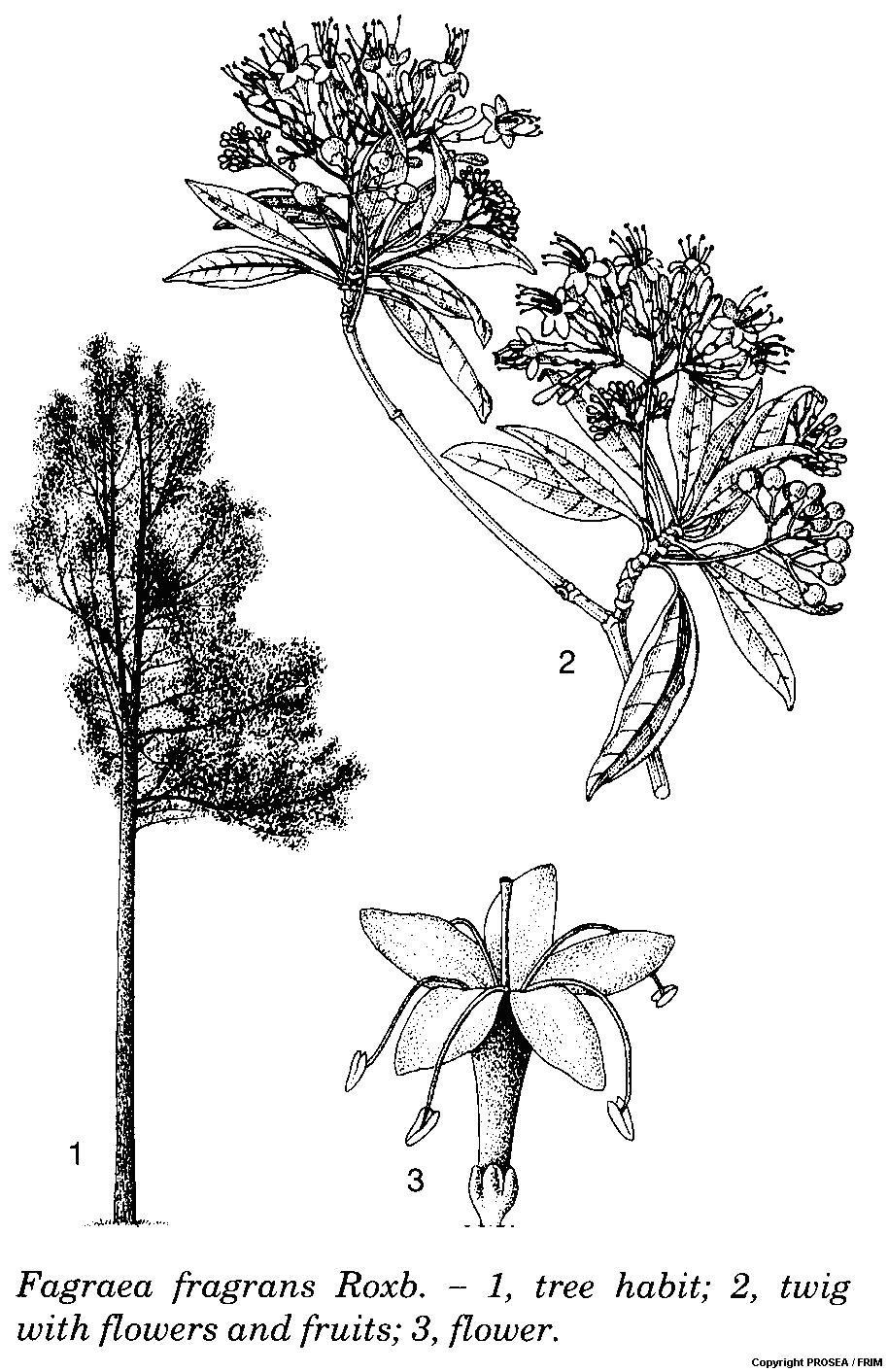Scientific Name
Fagraea fragrans Roxb.
Synonyms
Cyrtophyllum fragrans (Roxb.) DC., Cyrtophyllum giganteum Ridl., Cyrtophyllum lanceolatum DC., Cyrtophyllum peregrinum Reinw., Fagraea peregrina (Reinw.) Blume, Fagraea ridleyi Gand. [Illegitimate], Willughbeia fragrans Spreng. [1]
Vernacular Name
| Malaysia | Tembusu hutan, tembusu padang, tembusu tembaga [2] |
| English | Ironwood [2] |
| Indonesia | Ki badak (Sundanese); kayu tammusu (Sumatran); ambinaton (Kalimantan) [2] |
| Thailand | Kankrao (Central); man pla (Northern); thamsao (Peninsular) [2] |
| Laos | Man pa [2] |
| Myanmar | Anan, ahnyim [2] |
| Philippines | Urung (General); dolo (Tagbanua); susulin (Tagalog) [2] |
| Cambodia | Tatraou [2] |
| Vietnam | Trai [2]. |
Geographical Distributions
Fagraea fragrans is found in India (Bengal), Burma (Myanmar), the Andaman Islands, Indo-China, Thailand, Peninsular Malaysia, Singapore, Sumatra, Borneo, Sulawesi, the south-western Philippines and Yapen Island (Irian Jaya); naturalised in West Java. [2]
Botanical Description
F. fragrans is a member of the Gentianaceae family. It is a medium-sized or occasionally large tree up to 25(-55) m tall. Its bole measures up to 135(-250) cm in diametre, occasionally fluted or with buttresses up to 2.5 m high. The surface of the bark is deeply irregularly fissured and dark brown while the inner bark is brown to yellow. [2]
The leaves are oblong-Iance-shaped to obovate-oblong, measuring 4-15 cm x 1.5-6 cm and usually with short to long, broadly acuminate apex. The secondary veins are slightly prominent to indistinct below, 1-2.5 cm long petiole while the stipules are rounded and partly free from the petiole. [2]
The inflorescence is an axillary while the pedicel and bracteoles are at or below the middle. The flowers are fragrant, with narrowly funnel-shaped petal tube, measuring 0.7-2.3 cm long, with headed stigma and faintly 2-lobed. [2]
The fruit is 0.7-1 cm long, broadly ellipsoid and orange or red. [2]
Cultivation
F. fragrans occurs in light primary and secondary forests in humid or seasonally inundated locations, but it avoids stagnant water. It grows well in poorly-aerated, compact clay soils, and in poor sandy or shallow sandstone soils. In freshwater swamp forests, it is found in association with Melaleuca spp. It also occurs naturally as a pioneer in burnt-over areas and “lalang” grasslands. The density of the wood is 510-930 kg/m3 at 15% moisture content. [2]
Chemical Constituent
F. fragrans has been reported to contain fagraldehyde, gentiopicroside, sweroside, swertiamarin, gentianine, pinoresinol, naucledal, gentiogenal. [2]
Plant Part Used
Leaves, bark. [3]
Traditional Use
The Kadazan use the F. fragrans leaves and bark to treat pancreatitis and gastric pains by applying the pounded leaves and bark over the lesion while at the same time drinking a decoction of the same. The bark is also used in the treatment of jaundice where the powdered dried bark is taken. In neonatal jaundice a decoction of the bark is given instead. [3]
The decoction of the leaves is a remedy for dysenteri. It is used to treat malaria whereby a decoction of either the leaves, bark, or root. [3]
The leaves of F. fragrans together with roots of Amaranthus sp. is boiled and given 5 to 6 days after the end of menstruation to ensure subsequent ease of flow [3]. The bark is febriguge. [4]
Preclinical Data
Pharmacology
Antimicrobial activity
Sweroside was isolated from the stem bark, roots, fruits and stems of F. fragrans. It was found to have mild anti-HSV-1 (Herpes simples virus type 1) activity. [5][6]
Antibacterial activity
Pinoresinol, naucledal and gentiogenal were isolated from various parts of F. fragrans showed antitubercular activity against Mycobacterium tuberculosis (H37Ra). [6]
Antimalarial activity
A secoiridoid aglycone isolated from the bark and leaves of F. fragrans called fagraldehyde was found to be weakly active against Plasmodium falciparum [5]. Pinoresinol, another isolate of F. fragran Roxb., also showed antiplasmodial activity against P. falciparum (K1 strain) [6].
Cytotoxic activity
Naucledal and gentiogenal was isolated from F. fragrans. They were found to exhibit cytotoxicity towards NCI-H187 cell lines. [6]
Toxicity
No documentation
Clinical Data
No documentation
Poisonous Management
No documentation
Line Drawing

References
- The Plant List. Ver 1.1. Fagraea fragrans Roxb. [homepage on the Internet]. c2013 [update 2012 Mar 23; cited 2016 Aug 25]. Available from: http://www.theplantlist.org/tpl1.1/record/kew-2807419
- Lemmens RHMJ, Soerianegara I, Wong WC, editors. Plant Resources of South-East Asia No.5(2): Timber trees: Minor Commercial Timbers. Leiden, Netherlands: Backhuys Publishers; 1995.
- Mat-Salleh K, Latif A. Tumbuhan ubatan Malaysia. Bangi, Selangor: Pusat Pengurusan Penyelidikan Universiti Kebangsaan Malaysia; 2002; p. 519.
- Nadkarni KM, Nadkarni AK. Dr. K.M. Nadkarni’s Indian Materia Medica. Volume 2. Popular Prakashan Pvt. Ltd; 1976; p.534.
- Jonville MC, Capel M, Frédérich M, Angenot L, Dive G, Faure R, Azas N, Ollivier E. Fagraldehyde, a secoiridoid isolated from Fagraea fragrans. J Nat Prod. 2008 Dec;71(12):2038-40.
- Apisantiyakom S. Isolation and identification of bioactive chemical constituents of the roots of Bauhinia saccocalyx Pierre and Fagraea fragrans Roxb. PhD thesis [unpublished dissertation]. Thailand: School of Chemistry, Suranaree University of Technology; 2004. [cited 2010 Oct 8] Available from: http://203.158.6.22:8080/sutir/bitstream/123456789/1153/2/samneang_fulltext.pdf


